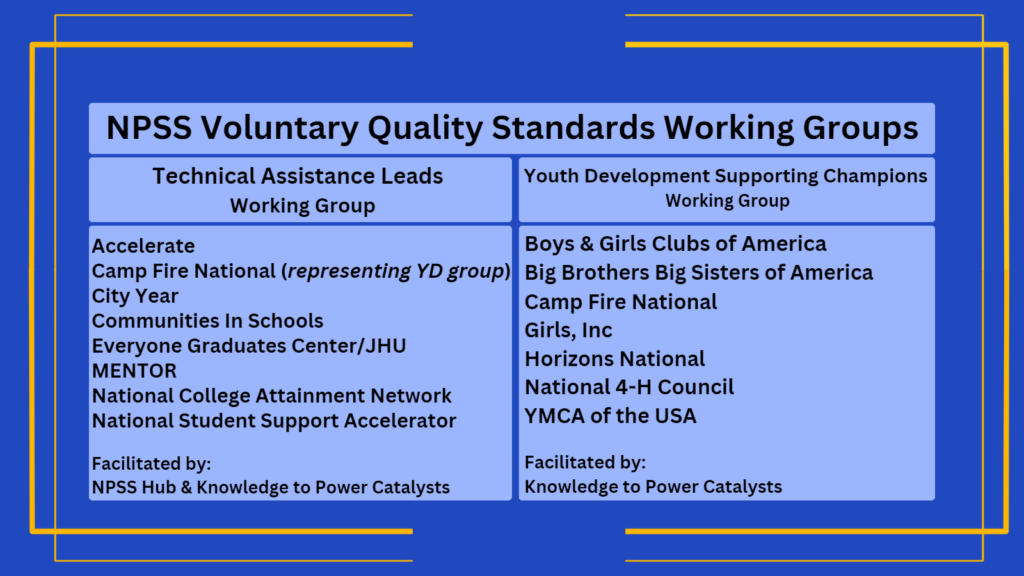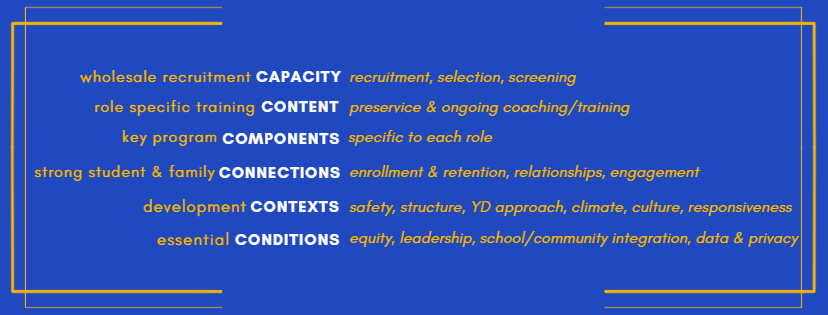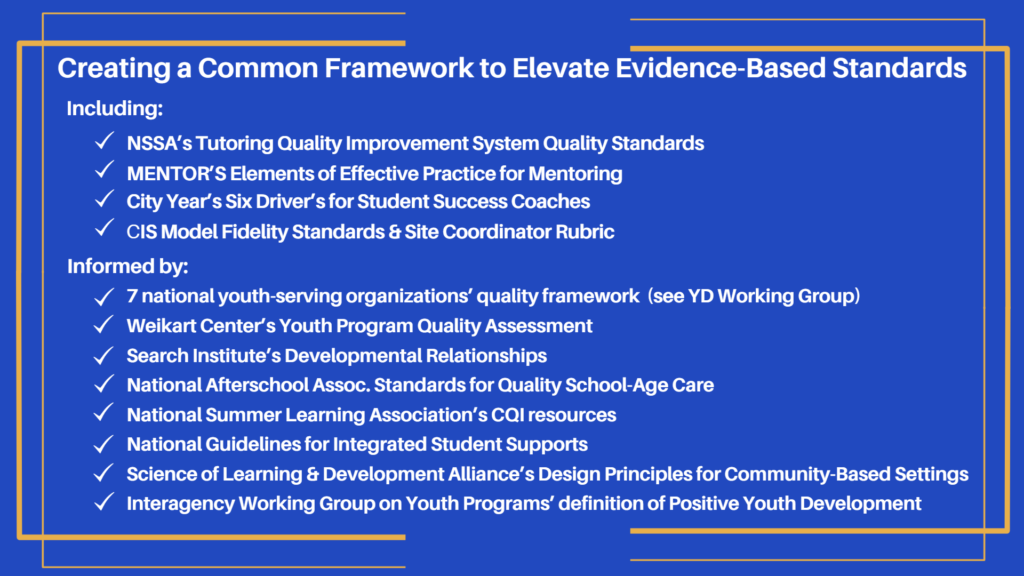NPSS’ Work to Widen the Pathway

I’m excited to share and celebrate a key milestone in the journey of the National Partnership for Student Success (NPSS) that was launched as a response to President Biden’s call to action in his previous State of the Union.
The milestone? Monday’s release of the NPSS Voluntary Quality Standards – a key marker on the path towards reaching the NPSS goal that 250,000 more Americans are playing essential evidence-based, relationship-rich roles in the lives of our young people, who are on their own path of forging forward out of these pandemic years.
For more on the impetus behind the Voluntary Quality Standards and hopes for how they will be used to promote five key roles in the lives of young people, – high-impact tutors, mentors, success coaches, post-secondary transition coaches and wraparound/integrated support coordinators – see the blog by Kate Cochran, NPSS Hub Director and colleagues from Communities in Schools and MENTOR.
As we amplify this work, I wanted to share with you more detail on the incredible collective effort that led to the creation of this “crosswalk” framework and set of standards.
After the exciting midsummer launch of the National Partnership, one of the first challenges to tackle was how do we get to quality at scale with speed? And how do we so in a way that builds for long-term sustainability while addressing the urgency of the present – when the need for more hands on deck is only exacerbated by the very real squeeze on educators and on the child- and youth-focused workforce broadly defined, whether they are in the classroom, counselor’s office, or community-based organization.
But what is a way to continue scaling their high-quality work quickly, and in ways that are increasingly visible to school partners who are seeking to increase multiple supports for their students? The answer: Build upon, not build anew. This massive effort to recruit, train and place staff or volunteers in high-quality programs requires understanding that these roles show up in multiple places and spaces. The NPSS Supporting Champions – over 100 organizations and growing – represent a vast ecosystem of programs, networks, and professional associations that are dedicated to providing people, programs, and possibilities for young people – with quality, at scale, and in ways that are sustainable.
To connect the expertise of the TA Leads with the scale potential of the NPSS Supporting Champions, we started with, quite literally, getting on the same page. Since last fall, I’ve had the privilege of co-facilitating two working groups – one primarily of TA Leads and one of national youth-serving organizations.
Very quickly, our mantra became “Build Upon, Not Build Anew”– identifying and building upon the evidence base and quality standards developed by practitioners and experts in the delivery of the five essential roles. For each of the five roles, there are dedicated NPSS TA Leads that bring a depth of research knowledge, practical expertise, and field connections.
But what is a way to continue scaling their high-quality work quickly, and in ways that are increasingly visible to school partners who are seeking to increase multiple supports for their students? The answer: Build upon, not build anew. This massive effort to recruit, train and place staff or volunteers in high-quality programs requires understanding that these roles show up in multiple places and spaces. The NPSS Supporting Champions – over 100 organizations and growing – represent a vast ecosystem of programs, networks, and professional associations that are dedicated to providing people, programs, and possibilities for young people – with quality, at scale, and in ways that are sustainable.
To connect the expertise of the TA Leads with the scale potential of the NPSS Supporting Champions, we started with, quite literally, getting on the same page. Since last fall, I’ve had the privilege of co-facilitating two working groups – one primarily of TA Leads and one of national youth-serving organizations.

Early on, these groups worked in tandem to affirm an organizing framework that can be used as a “crosswalk” connecting existing quality and continuous improvement efforts across the five roles and to youth work more generally. Given the focus of NPSS on expanding the numbers in these roles, this crosswalk framework starts with recruitment and training and then leads to other aspects of quality (see box below).

Looking across their standards and informed by the decades of work to promote quality across the allied youth fields (see below), the NPSS Voluntary Quality Standards Working Group affirmed 18 common elements across the “6 C’s” above. They also clarified and lifted up standards that are distinct to each role.
I would like to express kudos and appreciation to the working groups. The TA Leads’ passionate attention to detail and affirmation of common ground was both everything one could hope for and completely astounding. The YD Supporting Champions’ willingness to crosswalk their work to inform and test this emerging framework was also collegial and incomparable. Special shoutout to Shawna Rosenzweig at Camp Fire for pulling double duty and serving on both working groups.

What’s next?
As national and local organizations look to cross-train their existing staff as well as expand their team, the hope is that this crosswalk will help identify what they already have in place and “build upon” their existing staff development and continuous quality improvement efforts. For example, coming out of this work, Camp Fire National has already identified that over half of their affiliates are interested in incorporating high-impact tutoring into the array of supports they currently provide young people and the quarter of affiliates that currently offer tutoring are interested in joining a learning group to both offer expertise and continue improving their work in this area.
The TA Leads have processes in place for working with programs and places around the individual roles – offering technical assistance and resources that state and community leaders can tap into now – and they are looking next to find efficiencies as they cross-pollinate across their own networks and within the constellation of Supporting Champions.
Also, as new efforts get underway to maximize the service-to-educator and service-to-youth worker pipeline – another focus of NPSS – these standards and the depth of technical assistance and professional development resources that go along with them can be used in “building new” pathways as well.
And from the outset, there has been a “7th C” holding conceptual space across the bottom of the Voluntary Quality Standards page. That 7th C? Coordination. Any effort for quality at scale must build upon and strengthen the “coordination horsepower” at both the state and local level. We’re kicking off the next working group to identify practical ways to maximize and support local infrastructure – provider networks, intermediaries, children’s cabinets, opportunity youth networks – that are also committed to promoting quality at scale and with sufficient speed and sustainability to make a difference in the lives of young people today, when they need it most.
Interested in “building upon”? Sign on and let me know.



No comment yet, add your voice below!